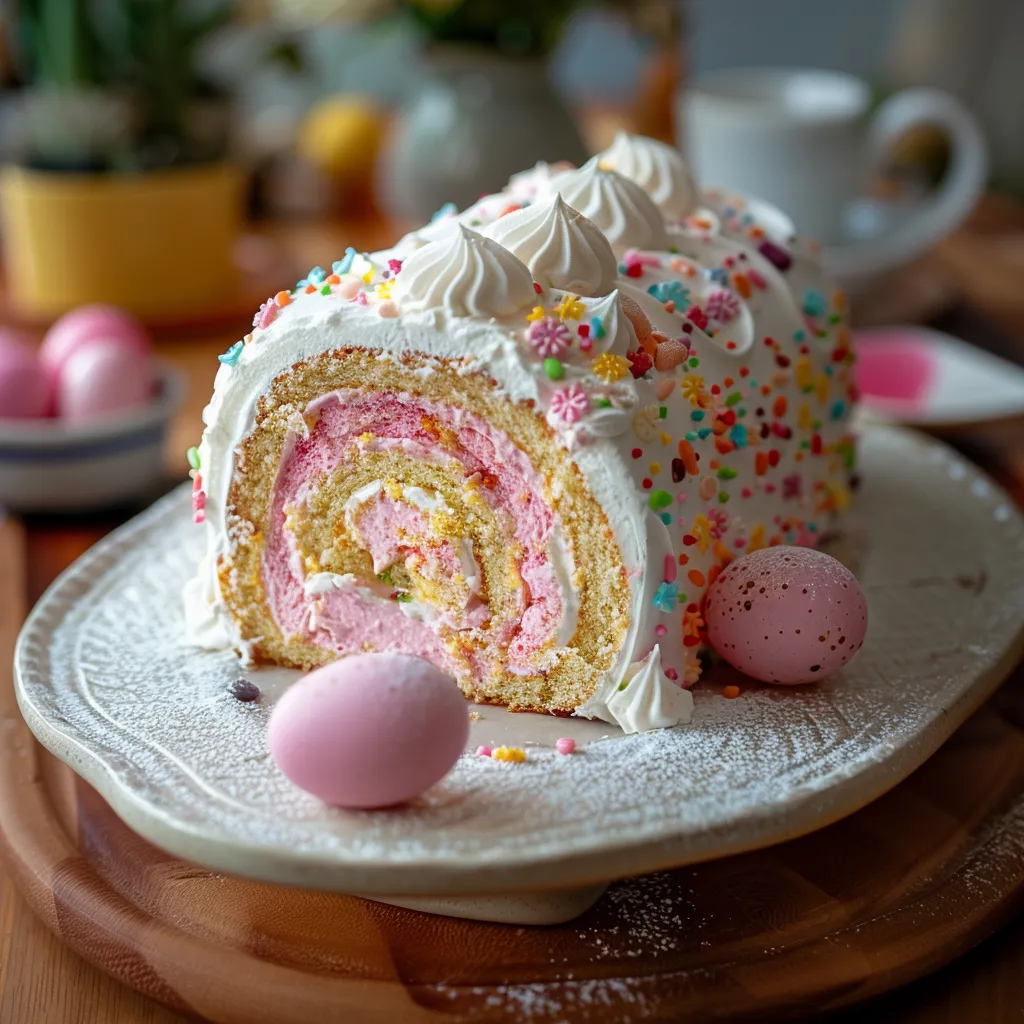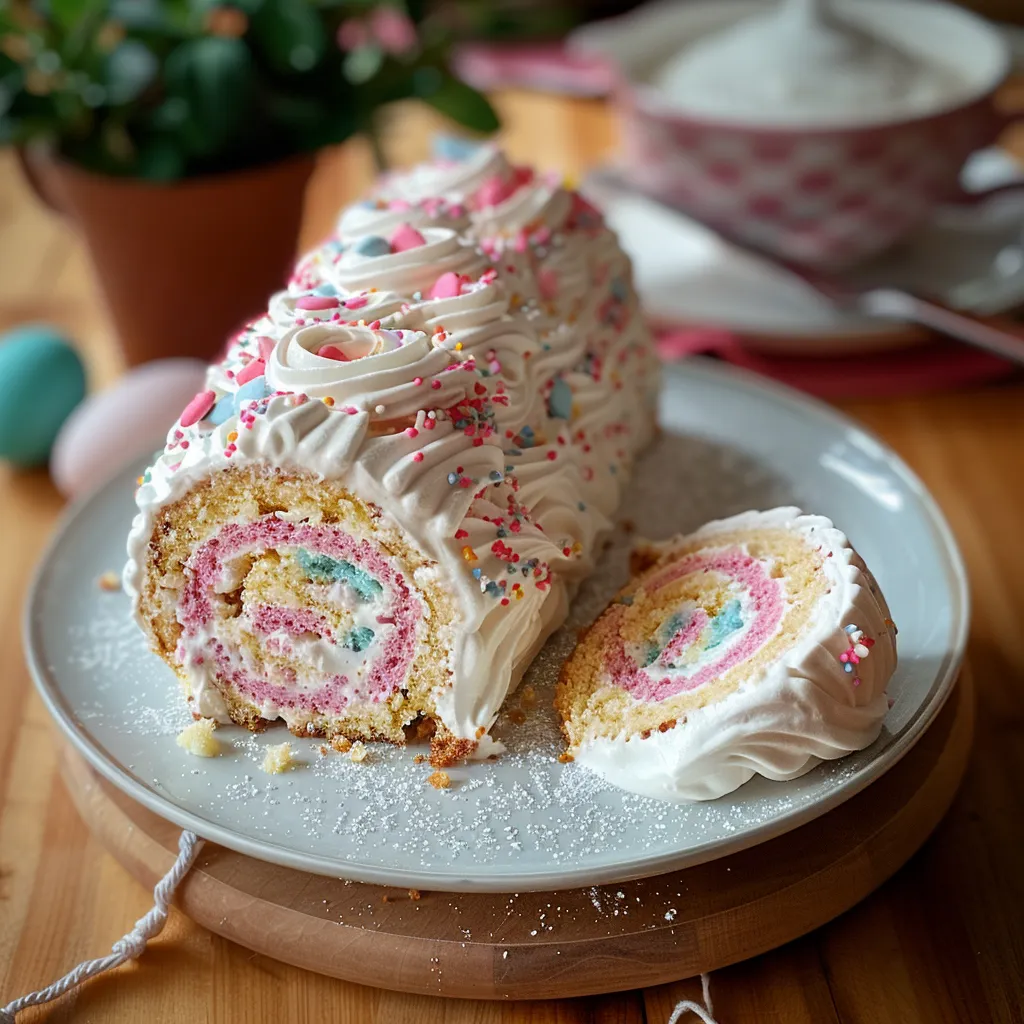 Pin to Favorites
Pin to Favorites
This Easter Cake Roll transforms any spring celebration with its perfect swirl of tender sponge cake and creamy filling. The festive dessert brings together light vanilla cake and smooth filling for a treat that looks impressive but requires minimal baking expertise.
I first made this cake roll during Easter brunch with my in-laws years ago. What started as a nervous attempt to impress my new family has become our most requested holiday tradition. The delight on everyone's faces when I bring out this swirled beauty makes the effort worthwhile every time.
Ingredients
- Eggs: At room temperature provide better volume and structure creating that perfect light texture
- Granulated sugar: Sweetens while helping create volume in the whipped eggs
- Vanilla extract: Adds warm aromatic flavor that enhances both cake and filling
- All purpose flour: Keeps the cake tender while providing necessary structure
- Baking powder: Creates the gentle rise needed without toughening the delicate sponge
- Heavy whipping cream: Whips into a cloud like filling with perfect sweetness
- Powdered sugar: Incorporates smoothly into fillings without any graininess
- Milk: Adds moisture ensuring your cake stays soft and prevents cracking when rolled
Step-by-Step Instructions
- Whip the Egg Mixture:
- Beat eggs and sugar for a full 3 to 4 minutes until the mixture becomes very pale yellow and nearly triples in volume. This intensive whipping incorporates air which acts as the main leavening agent for your cake. The mixture should fall from the beater in thick ribbons that sit on the surface briefly before disappearing.
- Create the Perfect Batter:
- Fold dry ingredients with extreme gentleness using a rubber spatula in a figure eight motion. Cut through the center then sweep around the bowl edges repeatedly just until no flour streaks remain. Overmixing will deflate your carefully whipped eggs resulting in a dense tough cake instead of the airy texture we need for successful rolling.
- Master the Rolling Technique:
- Turn hot cake onto the powdered sugar dusted towel immediately after removing from oven. Working quickly but carefully peel off parchment then start rolling from the short end using the towel as your guide. The cake must be rolled while warm to train its shape and prevent cracking. Let it cool completely in this rolled position to set its memory.
- Apply Filling Strategically:
- Spread filling to within half inch of all edges using an offset spatula for even distribution. Apply slightly thicker layer in the center where the tightest part of the spiral forms. This prevents filling from squeezing out during rolling and ensures every bite contains the perfect cake to cream ratio.
 Pin to Favorites
Pin to Favorites
This cake reminds me of my grandmother who taught me that the secret to a perfect roll lies in your confidence while rolling. I remember her hands guiding mine through my first attempt, explaining that even if it cracks, the filling covers many mistakes. Her wisdom applies to both baking and life.
Make Ahead Instructions
This Easter Cake Roll works beautifully as a make ahead dessert. Prepare the entire roll up to two days in advance keeping it well wrapped in the refrigerator. The cake actually improves with a rest period as the moisture from the filling slightly permeates the cake making it even more tender. For longer storage freeze the unfilled cake roll tightly wrapped for up to one month then thaw in the refrigerator overnight before filling and serving.
Festive Decorating Ideas
Transform your basic cake roll into a showstopping Easter centerpiece with simple decorative touches. Dust the top with additional powdered sugar for an elegant finish or create a simple glaze with 1 cup powdered sugar mixed with 2 tablespoons milk and drizzled over the top. For themed decorations add pastel colored sprinkles edible flowers or chocolate eggs nestled along the top curve of the roll. Children especially love helping with this decorating step making it a wonderful family activity.
Troubleshooting Common Issues
Cracked cake typically results from overbaking or rolling the cake when too cool. If small cracks appear do not worry as the filling will mask most imperfections. For significant cracks consider turning the roll into a trifle by cutting into cubes and layering with filling and fruit in a glass bowl. If your cake deflates during baking check your oven temperature with an independent thermometer as temperature fluctuations often cause collapse. Always use room temperature eggs for maximum volume and be extremely gentle when folding in flour to preserve the air bubbles that give the cake its structure.
 Pin to Favorites
Pin to Favorites
This elegant dessert ensures a delightful end to any Easter celebration while also being flexible for other celebrations throughout the year.
Frequently Asked Questions
- → How do I prevent the cake from cracking?
Roll the cake while it's still warm using a powdered sugar-dusted towel. This helps shape it and prevents cracks when unrolling later.
- → Can I use other fillings besides vanilla cream?
Yes! Try lemon cream, chocolate ganache, or cream cheese filling for a different flavor profile.
- → What is the purpose of dusting with powdered sugar?
The powdered sugar prevents the cake from sticking to the towel and adds a touch of sweetness.
- → How long should I chill the cake before serving?
Refrigerate the cake roll for at least 30 minutes to allow the filling to set and enhance the overall texture.
- → Can I make this cake roll ahead of time?
Yes! Prepare and refrigerate the cake roll a day in advance. Serve it chilled for best results.
